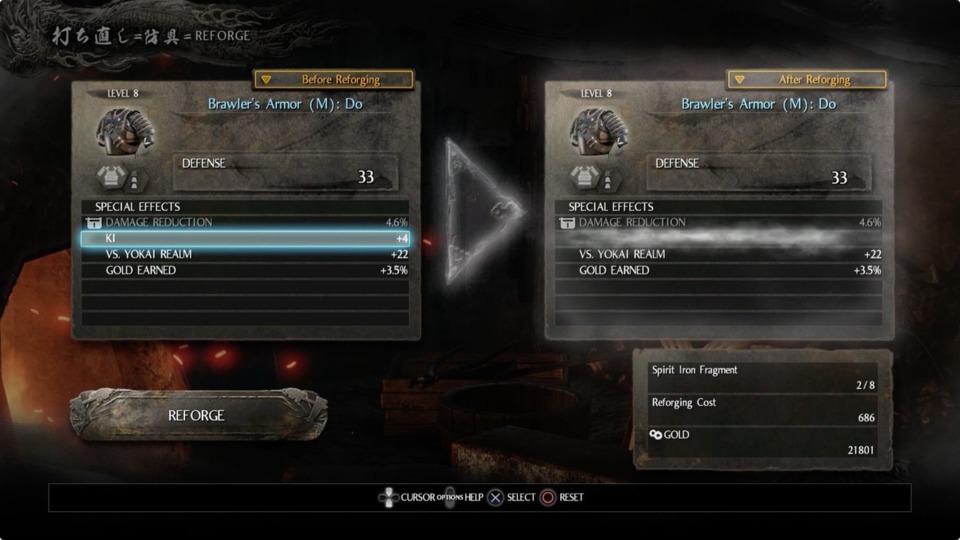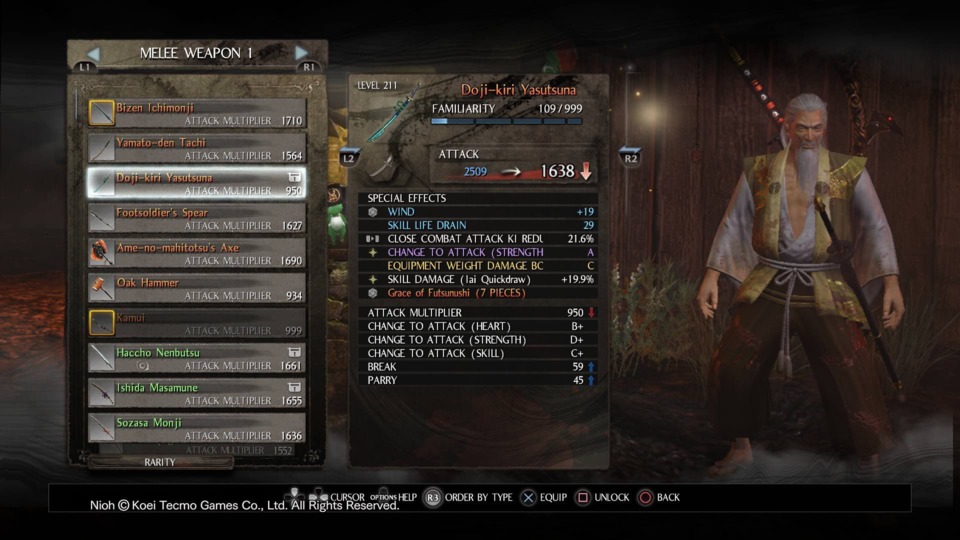The design schizophrenia of Nioh and my hopes for Nioh 2
By AtheistPreacher 4 Comments
I really liked the first Nioh, so much so that I logged 640 hours and 34 minutes playing it. It was a unique combination of combat that split the difference between Ninja Gaiden and From Software's Souls titles, plus a Diablo-like color-coded loot system, all of which are things I like. I've already pre-ordered the special edition of Nioh 2 (out on March 13, about a month away as I write this), and I don't often pre-order games anymore.
But I don't think there's any denying that Nioh had some weirdly inconsistent design, especially when it came to loot. Not only did some of its systems seem to clash internally, but in one case Team Ninja actually tried to fundamentally shift the design with the release of an update/DLC, only to reverse course with a later one. They just couldn't seem to decide whether they wanted Nioh to be a loot game for realsies, or an action game with some loot elements to it.
More loot, more problems
Let's start with this: efficient loot grinding in Nioh. For every loot game out there that you can think of, there are guides that instruct you in the quickest methods to get the best gear. Most loot games share a couple of fundamental design philosophies. First, the way to get better gear should always be primarily to engage in the core combat/gameplay. Second, it shouldn't be too easy to get absolutely optimal gear, otherwise you end the chase/grind prematurely.
Nioh did neither of these things, and the reason was its extremely generous "forging" and "reforging" systems.

First, almost every piece of equipment in the game could be "forged" at the blacksmith at the highest rarity tier simply by using some materials gotten by breaking down other items (in some cases you need a "Smithing Text," i.e. blueprint for the item). Second, each weapon or armor had something like six randomized properties (max) which each had a randomized numerical value, e.g. Close Combat Damage +10%-25%. "Reforging" allowed you to re-roll each individual property on any given piece of equipment one by one with no limits and no accelerating cost. Coupled with a little save-scumming, it was a fairly simple matter to keep re-rolling one property at a time on a piece of equipment until it was ideal, back up your save, and move on to the next, until you had the ideal piece of equipment.
What this meant was, first, that the end-game player taking the path of least resistance to good equipment spent a lot of time initially in the reforging screen re-rolling properties rather than actually playing the game. Second, it was a relatively quick and simple matter to get absolutely ideal equipment, making subsequent loot drops literally meaningless, because they could never be better than the item you'd spent time crafting. At that point, Nioh basically ceased to be a loot game at all.
Compare this to Diablo 3, which only allows you to re-roll a single property on a piece of equipment, and every time you do it, the cost on the next attempt goes up. Such a system gives you some scope to customize, but keeps you going back to playing the game to get a better item.
Now, to be clear, it isn't inherently bad to have a system where you can simply get ideal equipment and stop needing to improve it. Not every game needs to be a loot game with a never-ending chase for a marginally better weapon and a marginally better hat. There are plenty of action games (like Ninja Gaiden, for one!) that have a discrete number of new weapons or tools or whatever to unlock, and once you have them, all that's left is to keep re-playing the game as long as it amuses you.
But Nioh's implementation of loot was... a little bizarre. It's like they decided at some point in the game's absurdly long and troubled 13-year development cycle (it began development in 2004 and was released in 2017) that players seemed to like color-coded loot nowadays, and maybe they should include that, but didn't really understand the design principles behind modern loot games and just left things kind of conflicted and half-assed, design-wise.
You're right, let's change it... actually, no, wait, let's change it back!
Team Ninja peaked in its design indecisiveness/schizophrenia between the second and third of three DLC expansions. In the second expansion, Defiant Honor, they introduced a whole new tier of equipment: "ethereals," color-coded orange, which were above the previously highest tier of equipment, "divines," color-coded green.

Ethereals were different because they couldn't be forged, could contain properties that couldn't be reforged, and also had set bonuses that could not be acquired by fighting player "revenants," which was another way that players had been "trading" good equipment back and forth (actually, it's all even more complicated than this, but you get the picture). The clear design intent of ethereals was for Nioh to become more of a "real" loot game, in which you spend less of your time at the blacksmith and more time actually fighting enemies to get better stuff.
Then the third and final DLC came around, Bloodshed's End, which introduced a new system of "defiling" equipment in order to turn non-ethereal items into ethereal ones... essentially reversing the design intent of the previous DLC, and again allowing players to get their ideal equipment fairly easily and quickly.
Difficulty with difficulties
Then there was the structure of Nioh's difficulty levels, and the structure of difficulty per stage/mission within each setting. It is, of course, hardly unusual for action games to have multiple difficulty settings that are meant to be played consecutively (see, again, Ninja Gaiden). Historically, this hasn't been unusual for loot games, either: Diablo 2 had Normal, Nightmare, and Hell, which were meant to played one-after-another, in order to pad out the content before the end game. But while Diablo 3 started this same way, eventually Blizzard jettisoned the idea of multiple story mode playthroughs as too repetitive, and replaced it with end-game "torment levels" meant to extend the loot grind while allowing players to play the content they wanted, rather than the story mode endlessly. Most loot games these days follow this same sort of philosophy, from Borderlands 3 to The Division 2, etc.
Team Ninja didn't seem to get the memo on that. The game started out with two levels of difficulty, meant to be played consecutively, but they added three more, one with each of its three DLCs, meaning that by the end there were five discrete levels of difficulty, all of which had to be played all the way through in order to reach "end game."

Moreover, when you did reach the end, there was no mechanic to even out the difficulty of the individual missions/stages in order to make them equally viable end-game content. E.g., each mission had a set enemy level of anywhere between 1 and 1,220, and they stayed that way... meaning that in grinding for the best equipment in end-game, you were stuck playing the few missions in the final act/region that were high-level enough to drop worthwhile stuff, while ignoring most of the rest of the missions, limiting end-game variety (the "Abyss" mode addressed some of this, but had its own problems... I won't get into that here).
Again, the structure of Nioh's difficulty isn't inherently bad, but it doesn't gel particularly well with a loot game. I found the five separate difficulty levels bearable because I was playing them as the DLC came out, months apart. But as a new player, I think I would have been bored silly if I had needed to play the story through five times in a row before I could start to think about finalizing my equipment.
Maybe Nioh 2 will do this stuff better?
In short: Nioh doesn't actually need to be a loot game at all, the gameplay is strong enough that I think it would still be an excellent game even if the color-coded loot aspect of it was stripped out. But if you are going to have a system like that (and Nioh 2 so far looks like it emphasizes loot as much as its predecessor did), it would be nice if some of the other systems design choices complemented it a little better.
Probably my most desired design change in Nioh 2 as far as end-game goes is a final difficulty setting which evens out the levels of all the missions, so that every mission from the first to the last can have both an appropriate level of difficulty and appropriately rewarding loot drops for end-game players. Games like Diablo 3 have been doing this for a long time. It means you can grind on the content you want to grind on, without being restricted to playing the same few stages over and over again because they're the only challenging ones/they're the only ones that reward you with the best equipment.
Ideally, I'd also like to see fewer discrete consecutive difficulty settings. Five is just too many. It splits the playerbase for co-op and gets tedious besides. If the first suggestion above is taken, you can play the story through as many times as you want with an appropriate level of challenge, without being forced to.
Lastly, I'd like to see reforging in particular become more limited, simply so that I can continue to be excited by all that colored loot that keeps dropping, rather than knowing that whatever shiny new item has just dropped can't possibly be better than the one I've already got, because I spent hours save-scumming my current equipment to where nothing else can possibly beat it.
Ironically for me, the concerns I've laid out above are the only things that the preview coverage of Nioh 2 thus far doesn't seem to address. It shows new weapons, new enemies, new environments, and new mechanics, but there has been no information at all about how loot/crafting may have changed, or possible changes to levels of difficulty. I already know I'll like Nioh 2's core gameplay, and don't really need to see any more of it to be convinced that I want to play it. It's some of the systems surrounding it that could use some work. I guess we'll just have to wait and see if any of this has been addressed, or if this second game will stick to the same strangely inconsistent design decisions that the first one did. For me, the gameplay is good enough that it won't be a gamebreaker even if there are no substantial changes made to this stuff, but I sure would be pleased if Team Ninja has spent the past three years gaining a better understanding of how modern loot games work and has become more decisive about implementing supporting mechanics and systems.